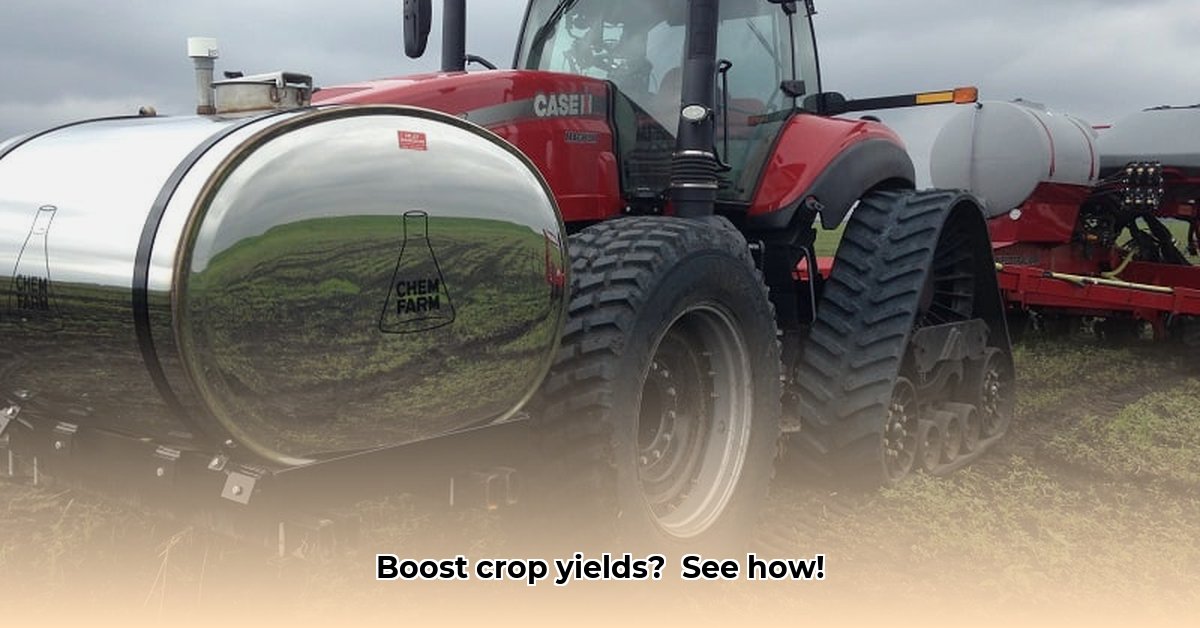
Choosing the right tractor tires can significantly impact your farm's productivity and long-term sustainability. Soil compaction, a silent yield thief, can be mitigated with flotation tires. This guide provides a practical, step-by-step approach to selecting and maintaining these specialized tires, maximizing your return on investment while minimizing environmental impact. For more tire size information, check out this helpful tire size chart.
Understanding Flotation Tires: Less Compaction, More Yield
Flotation tires are designed to reduce soil compaction, a major cause of reduced crop yields. Unlike standard tires, flotation tires distribute the tractor's weight over a much larger area, significantly lowering the ground pressure. This allows for better root penetration, improved water infiltration, and increased aeration—all crucial for healthy crop growth. Isn't maximizing your yield a top priority?
How Flotation Tires Work
The magic lies in the tire's design. A wider footprint and lower inflation pressure create a larger contact area with the soil, distributing the weight more evenly. This significantly reduces the pressure exerted on the soil, preventing the compression and damage that leads to compaction. Think of it like walking on soft sand with oversized shoes versus regular ones – you'll sink less with the wider footprint.
Types of Flotation Tires: Choosing the Right Fit
Flotation tires come in various types, each with its own set of advantages and disadvantages. The best choice for your farm will depend on several factors, including soil type, tractor size, and farming operations.
Key Features to Consider:
Tread Depth: Deep treads provide excellent traction in muddy or hilly conditions, while shallower treads are gentler on sensitive soils, minimizing disturbance.
Tire Size and Construction: Larger tires generally have a higher load capacity, essential for heavier tractors and implements. Radial tires often provide better durability and ride quality than bias-ply tires, but they can be more expensive.
Material: The tire material impacts things like longevity and puncture resistance. Some materials are better suited than others for particular soil types.
| Tire Feature | Option 1: Deep Tread Radial (e.g., VF tires) | Option 2: Shallow Tread Bias | Ideal Use Cases |
|---|---|---|---|
| Tread Depth | Deep (for excellent traction in challenging conditions) | Shallow (for minimal soil disturbance in sensitive soils) | Heavy clay soils, hilly terrain; light, sandy soils |
| Construction | Radial (longer lifespan, smoother ride) | Bias (more flexible, potentially lower cost) | Heavy-duty work; lighter applications, cost-sensitive operations |
| Load Capacity | High | Moderate | Large tractors, heavy implements; smaller tractors |
Choosing the Right Flotation Tires: A Step-by-Step Guide
Selecting the appropriate flotation tires requires careful consideration of various factors. This step-by-step guide will help you navigate this decision.
Assess Your Soil Type: Sandy soils may require shallower treads to minimize compaction, while heavier clay soils benefit from deeper treads for better traction. Knowing your soil composition is your cornerstone for the rest of this process.
Determine Your Tractor's Specifications: Check your tractor's manual for the recommended tire size and load capacity. Using tires beyond the stated limits can lead to damage and decreased efficiency.
Evaluate Your Operations: The tasks you perform with your tractor, such as planting, harvesting, or spraying, will dictate the type of traction and maneuverability you need. Do you need a durable tire for difficult terrain, or something more suited for delicate crops?
Set Your Budget: Flotation tires are a considerable investment, so establish a budget that reflects both your needs and your financial resources. Factor in not just purchase price, but the long-term value represented by increased yields and reduced maintenance needs.
Consult an Expert: Speak to your local agricultural supply dealer or tire specialist. Their expertise will help you select the optimal tires for your unique circumstances.
Tire Maintenance: Maximizing Lifespan and Performance
Regular tire maintenance is vital to maximizing their lifespan and ensuring optimal performance. Neglecting this aspect can lead to premature wear, costly repairs, and reduced yields.
Check Inflation Regularly: Incorrect inflation is a leading cause of premature tire wear. Consult your tire's sidewall for the recommended pressure and check it frequently, adjusting as needed.
Inspect for Damage: Regularly inspect your tires for cuts, punctures, or other damage. Address any problems promptly to prevent further deterioration.
Rotate Your Tires: Rotating your tires helps to ensure even wear across all tires, extending their lifespan.
Proper Storage: During the off-season, store tires in a cool, dry location, away from direct sunlight and extreme temperatures.
Environmental Considerations: Sustainable Farming Practices
While flotation tires offer significant benefits for soil health, it's crucial to consider their overall environmental impact. Research into the entire lifecycle of these tires—from manufacturing to disposal—is ongoing. The sustainability of the materials used, potential for recycling, and the ultimate environmental footprint require continued investigation. Choosing tires from manufacturers actively pursuing more sustainable practices is an important step toward a greener approach.
Conclusion: A Sustainable Path to Enhanced Productivity
Investing in the right flotation tires is a crucial step towards sustainable and profitable farming. By carefully following the steps outlined in this guide, you can make an informed decision that will not only improve your yields and protect your land but also contribute to more environmentally responsible farming practices. Prioritizing soil health is not just good for your wallet; it is vital for the health of the planet too. Remember: A healthy soil leads to a bountiful harvest and a sustainable future.